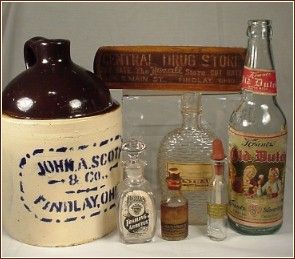I can't find my Aunt Sally!
Here's a great little embossed product jar that we picked up recently. The Redbook #10 Fruit Jar guide lists it as #175 -- in a 16 oz/pint size. Ours is an 8-1/4 oz/ 1/2pt size, 4-1/2" tall, small 2-1/4" mouth. Several fruit jar collectors saw my jar at the 2013 Muncie fruit jar get together, and commented that they hadn't ever seen this jar.Naturally, I went online and tried to find out more about Aunt Sally's Brand / Pasadena California. Who was she? What was sold in this jar?
Alas, there was no information to be found, anywhere. Not even an old ebay sale of another jar. I could try local city directories, which would just confirm time/place. I'm hoping for a little company history and to find out who Sally was. It seems I shall have to wait until someone posts something someday.
And there's more mystery about the maker of the jar itself. The glass company mark, on the heel, is an embossed 'Co' monogram, with a small o inside a C. We showed it to the knowledgeable collectors at Muncie, and I researched that mark online, and again, not found. The base just has an embossed number 8.
She Contains Multitudes
My apologies to Walt Whitman... a google search on the name Aunt Sally certainly had multitudes of responses. For example:
- Aunt Sally / noun, Chiefly British / a person who is a ready target for criticism or focus for disputation.
- "The term 'Aunt Sally' is used as a political idiom, indicating a false adversary or straw man, set up for the sole purpose of attracting negative attention and wasting an opponent's energy."
- "an object of criticism or contention; especially : one that is set up to invite criticism or be easily refuted"
- Chaucer's The Canterbury Tales introduction as translated by David Wright---"In the fourteenth century the institution of marriage was an accepted Aunt Sally:..."
"The aunt part of the name may refer to an old black woman, a term employed both by blacks and whites in the USA from the eighteenth century onwards but also known in London; aunt could also be applied familiarly to any elderly woman.
The direct influence, according to J Redding Ware’s Passing English of the Victorian Era of 1909, may have been an 1820s black-face doll that derived from a low-life character named Black Sal who had been created by Pierce Egan in his series Life In London of 1821."
Mathematically Speaking
- PEMDAS = Please Excuse My Dear Aunt Sally = Parentheses, Exponents, Multiplication, Division, Addition, Subtraction
And then there's those gooey yummy Southern pralines:
Countless Other Aunt Sally's
Oh boy, did I find lots and lots of other Aunt Sally's. Here's a small accounting of just some of the myriad Aunt Sally's who aren't mine!She isn't a game:
 Aunt Sally rose to general popularity in Victorian times as a vulgar misogynist/racist fairground pursuit.
Aunt Sally rose to general popularity in Victorian times as a vulgar misogynist/racist fairground pursuit.The game of Aunt Sally goes back at least as far as the 17th Century. It may have been introduced by Royalist soldiers during the English Civil War when Charles set up court in Oxford.
She isn't a vintage household product:
Hoo Doo that Voo Doo? Aunt Sally do, that's who do!
The Numbers Have It
"A curiosity of hoodoo magic for gambling luck, Aunt Sally's Policy Players Dream Book consists of nine separate alphabetical lists of objects and situations found in dreams with interpretations and lucky numbers for playing policy, an illegal (and now obsolete) lottery once popular in the black community."
"Dream books -- of which Aunt Sally's Policy Players Dream Book is by far the best-known -- are part of the African-American hoodoo tradition. They link dream images (e.g. dream of a cook or dream of a locomotive) to divinatory meanings (e.g. "you will receive a letter" or "beware a strange man") and they also give numbers for betting (e.g. 5-14-50 or 65-41-55)."
"POLICY soon spread around the country despite anti-policy laws. Eventually the use of the term 'policy' came to imply an African-American clientele, while Italian-Americans called it "the numbers"."
"The name 'policy' may have come from a verbal code that the numbers runners (ticket sellers) used when collecting bets on the street: "Would you like to take out an insurance policy?" they asked. One could also play at a policy shop or policy office, where the bets were taken and the stakes held by policy writers."
I dreamed of Aunt Sally with the...
I got the Aunt Sally's Blues
She's heavy, but she's not my Auntie
_______________________________________________
Findlay Antique Bottle Club


















No comments:
Post a Comment
Please leave us a comment - we love to hear what you have to say!